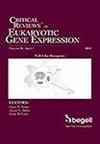FTO-mediated m6A modification of FTH1 inhibits ferroptosis of neurons in neonatal cerebral hypoxic ischaemia
IF 1.5
4区 医学
Q4 BIOTECHNOLOGY & APPLIED MICROBIOLOGY
Critical Reviews in Eukaryotic Gene Expression
Pub Date : 2024-06-01
DOI:10.1615/critreveukaryotgeneexpr.2024054011
引用次数: 0
Abstract
FTO is aberrantly expressed in brain disorders. However, the roles of FTO in neonatal hypoxic-ischemic brain injury (HIE) are still unclear. This study aims to investigate the potential of FTO in neonatal HIE. Oxygen-glucose deprivation (OGD) was used to establish HIE in vitro. mRNA levels were detected by RT-qPCR. Protein expression was detected by western blot. The levels of MDA, SOD, Fe2+ and GSH was detected by specific kit. m6A sites were analyzed using SRAMP and further verify by MeRIP assay. Cell proliferation was determined by CCK-8. Cell death was determined by PI staining. FTO was downregulated in patients with neonatal HIE and OGD-treated neurons. Moreover, FTO mRNA expression was decreased in ferroptosis inducer, especially FAC. However, overexpression of FTO inhibited the ferroptosis of neurons. Moreover, FTO-mediated m6A modification of FTH1 suppressed its mRNA expression and stability, inhibiting its protein expression. However, overexpression of FTH1 abrogated the effects of FTO and promoted the ferroptosis of neurons. In summary, FTO functions as a protective role in neonatal HIE via inhibiting FTH1 signaling. Thence, targeting may be a promising strategy for FTO neonatal HIE.FTO 介导的 FTH1 m6A 修饰可抑制新生儿脑缺氧缺血时神经元的铁蜕变
FTO 在脑部疾病中异常表达。然而,FTO在新生儿缺氧缺血性脑损伤(HIE)中的作用仍不清楚。本研究旨在探讨 FTO 在新生儿 HIE 中的潜在作用。通过 RT-qPCR 检测 mRNA 水平。蛋白表达采用免疫印迹法检测。使用 SRAMP 分析 m6A 位点,并通过 MeRIP 检测进一步验证。用 CCK-8 测定细胞增殖。细胞死亡通过 PI 染色测定。新生儿 HIE 患者和经 OGD 处理的神经元中 FTO 下调。此外,FTO mRNA 在铁变态反应诱导剂(尤其是 FAC)中表达减少。然而,过量表达 FTO 可抑制神经元的铁突变。此外,FTO 介导的 FTH1 m6A 修饰抑制了其 mRNA 的表达和稳定性,抑制了其蛋白质的表达。然而,过量表达 FTH1 可减弱 FTO 的作用,促进神经元的铁凋亡。总之,FTO 通过抑制 FTH1 信号转导在新生儿 HIE 中发挥保护作用。因此,靶向治疗可能是治疗 FTO 新生儿 HIE 的一种有前途的策略。
本文章由计算机程序翻译,如有差异,请以英文原文为准。
求助全文
约1分钟内获得全文
求助全文
来源期刊

Critical Reviews in Eukaryotic Gene Expression
生物-生物工程与应用微生物
CiteScore
2.70
自引率
0.00%
发文量
67
审稿时长
1 months
期刊介绍:
Critical ReviewsTM in Eukaryotic Gene Expression presents timely concepts and experimental approaches that are contributing to rapid advances in our mechanistic understanding of gene regulation, organization, and structure within the contexts of biological control and the diagnosis/treatment of disease. The journal provides in-depth critical reviews, on well-defined topics of immediate interest, written by recognized specialists in the field. Extensive literature citations provide a comprehensive information resource.
Reviews are developed from an historical perspective and suggest directions that can be anticipated. Strengths as well as limitations of methodologies and experimental strategies are considered.
 求助内容:
求助内容: 应助结果提醒方式:
应助结果提醒方式:


